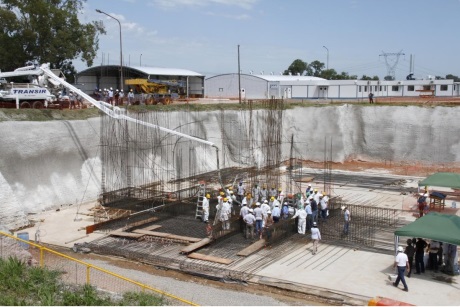The pouring of first concrete has marked the official start of construction of Argentina's prototype CAREM-25, a domestically-designed and developed small integral reactor.
 |
| Workers pour concrete for CAREM-25's basemat (Image: Ministry of Federal Planning) |
A ceremony on 8 February marked the formal start of construction work at the reactor. It was attended by, among others, chairman of Argentina's National Atomic Energy Commission (CNEA) Norma Boero, CAREM area manager Osvaldo Calzetta and Jose Luis Antunez, president of utility Nucleoeléctrica Argentina SA.
Boero noted, "Although there are other similar reactor projects in the world, this is the first to start construction, which is a pride not only for the nuclear industry but for all Argentinians."
Commenting on the start of construction, federal planning minister Julio De Vido said: "Today is a historic day because this birth of CAREM, which is of national design and technology, continues to deepen the relaunch of nuclear development."
CAREM - the name is taken from Central ARgentina de Elementos Modulares - is a domestically-designed and developed 25 MWe small pressurized water reactor. The prototype of the design, CAREM-25, is being built at a site adjacent to the Atucha nuclear power plant in Lima, 110 km northwest of Buenos Aires. At least 70% of the components and related services for CAREM-25 are to be sourced from Argentine companies.
According to the CNEA, the unit - being built at a cost of some ARS3.5 billion ($446 million) - is currently scheduled to begin cold testing in 2016 and receive its first fuel load in the second half of 2017.
As well as relying on passive safety systems, CAREM's entire primary coolant system is contained within the single self-pressurized vessel and uses free convection to circulate the coolant. This eliminates the need for devices such as pumps within the primary circuit and decreases the extent and complexity of the piping system required, as well as reducing the possibility of accidents involving a loss of coolant.
Once the design is proven, a larger 100-200 MWe version of the reactor is pencilled in to be built in the northern province of Formosa.
Researched and written
by World Nuclear News





_18570.jpg)
_18938.jpg)
_33584.jpg)
_82983.jpg)





